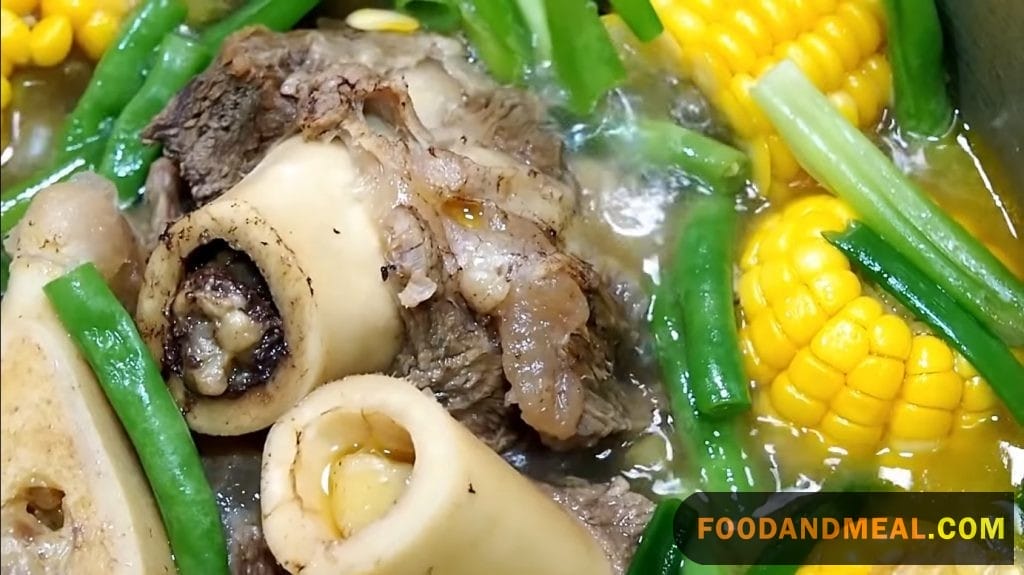Hello there, JaimeInez here! I’m thrilled to welcome you back to Food and Meal, where we celebrate the joy of cooking and the love for food. Today, I’m excited to share with you my recent culinary adventure with a delightful Filipino dish – the Masbate Bulalo. This journey has been nothing short of amazing, and I can’t wait to dive into the details with you. So, let’s embark on this gastronomic exploration together!

Masbate Bulalo
Equipment

Ingredients
- 2 pcs beef marrow bones cut into 2 to 3 pieces
- 1 lb. beef shank cut into serving pieces
- 2 pcs corn cobs cut into 2-inch pieces
- 3 baby bok choy leaves separated
- 1 pc onion quartered
- 3 garlic cloves minced
- 1 tsp black peppercorns
- 2 tbsp fish sauce
- Salt to taste
Instructions
- Bring a pot of water to boil over medium fire. Add beef shank and marrow bones and allow to boil for 10 minutes.
- Remove the meat and bones from the pot and scrub off scum.
- Place back the beef bones and meat into the pot with a fresh cup of water, enough to cover he meat.
- Add onion, garlic, and peppercorns. Season with fish sauce and bring to a boil.
- Reduce heat to low and simmer for about 5 hours or until the meat is super tender.
- Remove meat and bones using a slotted spoon, then, strain liquid through a fine mesh, discarding solids.
- Return both meat, bones, and soup into the pot.
- Add corn and simmer for about 20 minutes or until the corn is cooked through.
- Stir in bok choy and turn off heat.
- Serve warm.
Video
Notes
Calabarzon but it is also a staple in many celebrations in Masbate as proof of
its thriving cattle industry. What a perfect way to celebrate the Rodeo
Festival in May than to savor bulalo, together with beef shanks and bone
marrow. Although it takes time to cook the dish, it is pretty simple and easy
to put together.
Nutrition
© Food And Meal
This website provides approximate nutrition information for convenience and as a courtesy only. Nutrition data is gathered primarily from the Spoonacular Database, whenever available, or otherwise other online calculators.
About Masbate Bulalo

Masbate Bulalo is a beloved Filipino dish that originates from the province of Masbate. Known for its rich, savory broth and tender beef shanks, this dish is a comforting staple in many Filipino households. The process of slow-cooking the beef until it’s fall-off-the-bone tender is a labor of love, making this dish a true representation of Filipino culinary heritage.
Cooking Tips for Masbate Bulalo
- Quality of Ingredients: The quality of your beef shanks can significantly impact the taste of your Bulalo. Always opt for fresh, high-quality cuts.
- Patience is Key: Slow-cooking is essential to achieving the tender beef and flavorful broth characteristic of Bulalo. Don’t rush the process!
- Skimming is Important: Regularly skim off any impurities that rise to the surface of the broth to ensure a clear, clean-tasting soup.
Serving Suggestions for Masbate Bulalo

- Veggie Boost: Enhance the nutritional value and color of your dish by adding a variety of vegetables like cabbage, corn, and pechay (bok choy).
- Rice Companion: Serve your Bulalo with a side of steamed rice for a complete, satisfying meal.
- Sauce on the Side: A dipping sauce of calamansi (Filipino lime) and soy sauce adds a tangy contrast to the rich soup.
FAQs About Masbate Bulalo
- What Makes Masbate Bulalo Special? Masbate Bulalo is special due to its rich, savory broth and tender beef shanks, which are achieved through slow cooking.
- Can I Use Other Types of Meat? While you can experiment with other types of meat, using beef shanks is recommended to maintain the dish’s authenticity.
- What Vegetables Go Well with This Dish? A variety of vegetables such as cabbage, corn, and pechay (bok choy) go well with this dish.
- How Can I Store Leftovers? Leftovers can be stored in an airtight container in the refrigerator for up to 3 days.
- Can I Make It Vegan? While traditional Bulalo is not vegan, you could experiment with plant-based proteins and vegetable broth to create a vegan version.
In conclusion, Masbate Bulalo is more than just a dish; it’s a culinary experience that tells a story of Filipino culture and tradition. The process of making it requires patience and care, but the result is a comforting, flavorful dish that brings people together. Whether you’re a seasoned cook or a beginner, I hope these tips and suggestions inspire you to try making your own Masbate Bulalo at home. Happy cooking!

